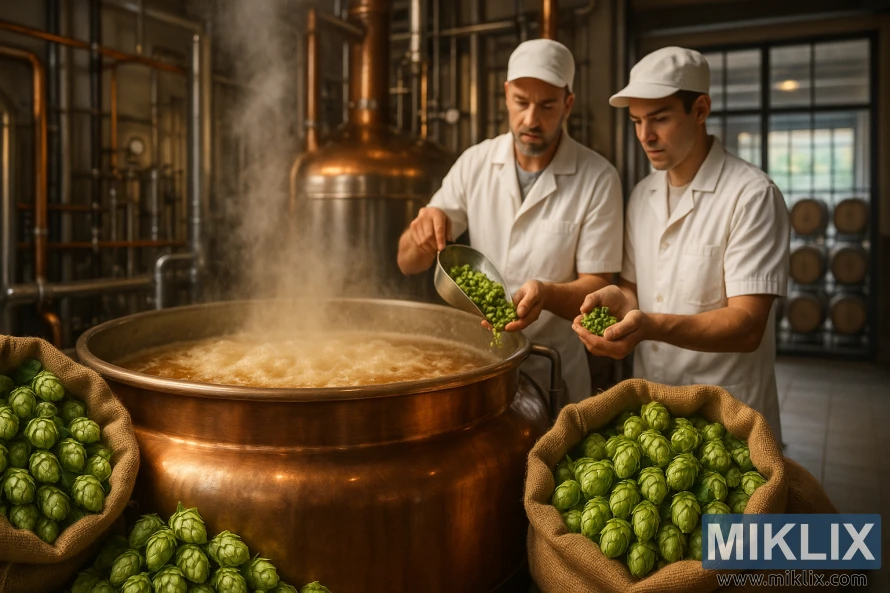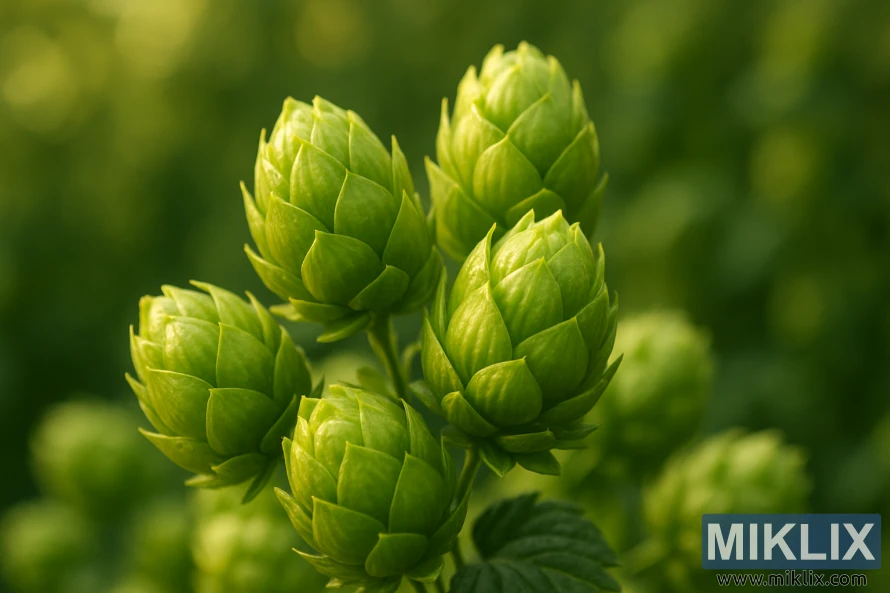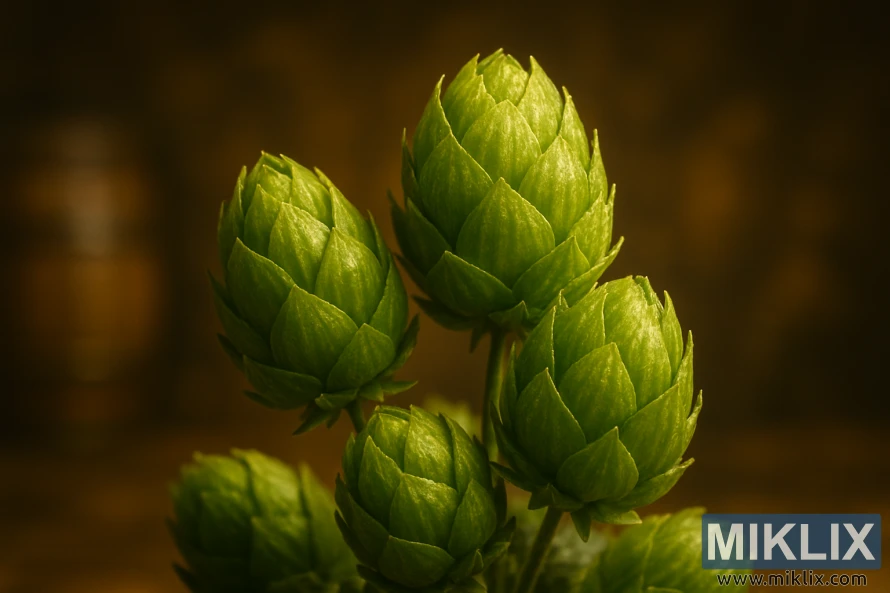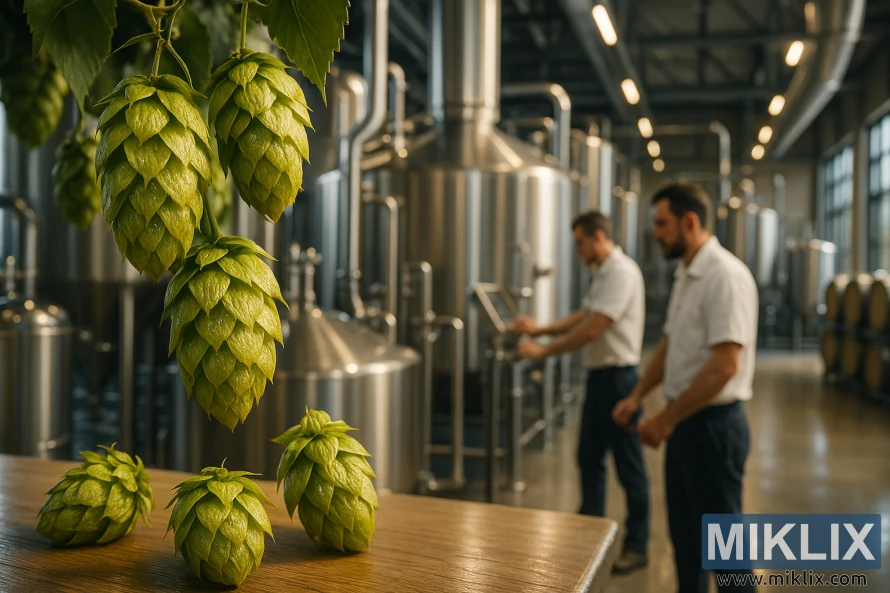Hops in Beer Brewing: Hersbrucker
Published: September 14, 2025 at 8:56:16 AM UTC
Hersbrucker is a noble hop variety from Southern Germany, known for its unique flavor and aroma profile. Originating from the Hersbruck region, this hop variety has become a popular choice among brewers for creating distinctive beers. The distinctive characteristics of Hersbrucker make it an ideal choice for various beer styles. It offers brewers a versatile ingredient for crafting delicious beers.

Key Takeaways
- Hersbrucker is a noble hop variety known for its unique flavor and aroma.
- It originates from Southern Germany and is popular among brewers.
- Ideal for various beer styles due to its versatility.
- Offers a distinctive flavor profile for crafting unique beers.
- A popular choice for brewers looking to create high-quality beers.
Origins and History of Hersbrucker Hops
Hersbrucker hops originated in the Hersbruck region, becoming a key component in traditional German beer brewing. They are celebrated for their distinct flavor and aroma, making them a noble hop variety.
The history of Hersbrucker hops is marked by their emergence as a substitute for Hallertauer hops, which were ravaged by disease. This necessity led to their cultivation, highlighting their durability and superior brewing quality.
The characteristics of Hersbrucker hops include:
- High-quality brewing properties
- Noble hop characteristics
- Resilience to disease
Among traditional German hop varieties, Hersbrucker hops stand out. Their history is deeply rooted in Germany's brewing traditions. This makes them essential in many classic beer recipes.
Understanding Hersbrucker Hops' Chemical Profile
Hersbrucker hops stand out due to their unique alpha and beta acids. This blend is key to their appeal among brewers. The chemical makeup of these hops includes alpha acids ranging from 1.5% to 5%. Beta acids fall between 2.5% and 6%.
The alpha acids in Hersbrucker hops are the main contributors to beer bitterness. On the other hand, beta acids are essential for the hop's aroma and flavor. This balance makes Hersbrucker hops suitable for a wide range of beer styles.
- Alpha acid content: 1.5-5%
- Beta acid content: 2.5-6%
- Contribution to bitterness and flavor
By grasping these characteristics, brewers can better plan their recipes. This knowledge helps optimize the brewing process for the desired results.
Aroma and Flavor Characteristics
Hersbrucker hops bring a distinct flavor to beers, with notes of hay, tobacco, and orange. Their aroma is mild to semi-strong, making them a go-to for brewers looking for versatility. This unique combination of flavors sets them apart in the brewing world.
The aroma of Hersbrucker hops adds a layer of complexity to beer. Brewers value the subtle yet rich flavors these hops offer. From floral and spicy notes to earthy undertones, Hersbrucker hops enhance the sensory experience of beer.
- Hersbrucker hops contribute a complex flavor profile, including notes of hay and tobacco.
- The orange notes in Hersbrucker hops add a citrusy dimension to beers.
- The mild to semi-strong aroma profile makes Hersbrucker hops versatile for various beer styles.
By using Hersbrucker hops, brewers can create a balanced flavor that appeals to many. These hops not only improve the aroma but also shape the beer's overall character. This makes them a valuable addition to any brewer's arsenal.

Growing Conditions and Harvesting
To produce high-quality Hersbrucker hops, farmers must carefully manage growing conditions. This includes ensuring the soil has the right balance of nutrients and pH levels, as well as implementing effective irrigation systems.
The region where Hersbrucker hops are grown plays a significant role in their flavor and aroma profile. Factors such as sunlight exposure, temperature fluctuations, and soil composition all contribute to the final product.
Hop farmers must also be vigilant about pest control and disease management. Regular monitoring and the use of integrated pest management techniques can help prevent damage to the crop.
Harvesting Hersbrucker hops typically occurs in the fall. The exact timing depends on factors such as weather conditions and the specific variety of hop. Farmers often harvest when the cones are fully ripe, as this is when the alpha and beta acids are at their peak.
- Key factors in harvesting Hersbrucker hops include:
- Monitoring weather forecasts to avoid damage from adverse conditions
- Carefully timing the harvest to maximize alpha and beta acid content
- Using appropriate machinery to minimize loss and damage during harvesting
By carefully managing growing conditions and harvesting techniques, farmers can produce Hersbrucker hops that meet the high standards of the brewing industry.
Alpha and Beta Acid Composition
Grasping the alpha and beta acid makeup of Hersbrucker hops is key for brewers. Alpha acids are the culprits behind beer's bitterness. Beta acids, on the other hand, shape the aroma and flavor. Achieving a balance between these acids is vital for the beer's character.
Hersbrucker hops typically have an alpha acid content between 2-5%. This moderate level is ideal for a range of beer styles. It ensures a balanced bitterness, making them versatile for brewers.
Beta acids, though not directly involved in bitterness, are essential for hop aroma and flavor. They significantly impact the hop character, playing a critical role in the brewing process.
- Alpha acids provide bitterness.
- Beta acids contribute to aroma and flavor.
- The balance between alpha and beta acids is critical for the beer's overall character.
By comprehending the alpha and beta acid composition of Hersbrucker hops, brewers can make informed decisions. This knowledge aids in effectively incorporating these hops into their recipes.
Best Beer Styles for Hersbrucker Hops
Hersbrucker hops are perfect for a variety of beer styles, from crisp lagers to hoppy pale ales. Their distinct flavor and aroma profile allow brewers to craft a wide range of beers. This versatility showcases the hops' unique qualities.
These hops are ideal for lagers, pilsners, and pale ales. In lagers, they add a subtle hoppy flavor and aroma. This complements the beer's clean, crisp character. In pilsners, Hersbrucker hops introduce a spicy, floral note, making the beer even more refreshing.
In pale ales, Hersbrucker hops offer a balanced mix of bitterness and flavor. They bring earthy and spicy notes. This makes them perfect for brewers aiming to create complex, hoppy beers with a distinct character.
Some of the best beer styles for Hersbrucker hops include:
- Lagers: Showcase the hops' subtle flavor and aroma.
- Pilsners: Highlight the spicy, floral notes of the hops.
- Pale Ales: Demonstrate the hops' ability to add complexity and balance.
By pairing Hersbrucker hops with complementary beer styles, brewers can create a wide range of beers. These beers showcase the unique characteristics of these versatile hops.

Optimal Brewing Applications
Hersbrucker hops are versatile in brewing, suitable for dry hopping and late boil additions. The best brewing methods for Hersbrucker hops depend on the beer's flavor and aroma goals.
These hops can be used in various brewing techniques. They add a unique flavor and aroma to beers, whether in traditional lagers or modern pale ales.
- Dry hopping: Enhances the aroma of the beer without adding bitterness.
- Late boil additions: Contributes to the flavor and aroma of the beer.
- Early boil additions: Can be used for bittering, though Hersbrucker hops are not known for high alpha acid content.
Understanding Hersbrucker hops' brewing applications allows brewers to experiment. This versatility makes them a valuable ingredient in many beer styles.
Storage and Preservation Methods
Hersbrucker hops need careful storage to keep their potency and flavor. They degrade quickly when exposed to light and heat. This is because they are a sensitive hop variety.
To preserve their quality, store Hersbrucker hops in a cool, dry place. Make sure it's away from direct sunlight. This helps keep their alpha and beta acids, as well as essential oils, in balance.
- Using airtight containers or packaging to prevent exposure to air and moisture.
- Keeping the storage area at a consistent refrigerated temperature.
- Minimizing handling to reduce the risk of damage.
By following these storage and preservation methods, brewers can ensure their Hersbrucker hops stay fresh. This contributes to the overall quality of their beers.
Common Substitutes for Hersbrucker Hops
Brewers looking to mimic Hersbrucker hops have several options. Hersbrucker hops stand out for their versatility. Yet, brewers might need to swap them out for other varieties at times.
Common substitutes include Hallertau, Mount Hood, and Liberty. Each offers unique flavor and aroma profiles.
Knowing the traits of these alternatives helps brewers make better choices. Here's a brief overview of each:
- Hallertau: Known for its mild, slightly spicy flavor and aroma, Hallertau is a traditional German hop variety.
- Mount Hood: This American hop variety is known for its mild, herbal flavor and aroma, making it a good substitute for Hersbrucker in many beer styles.
- Liberty: With its mild, slightly spicy flavor and aroma, Liberty is another popular substitute for Hersbrucker hops.
Exploring these alternatives allows brewers to achieve the desired flavor and aroma in their beers. This is true even when Hersbrucker hops are not available.
Recipe Development Guidelines
Creating beer recipes with Hersbrucker hops demands a deep understanding of their distinct flavor and aroma. Brewers must balance these unique traits with other ingredients to craft exceptional beers.
The first step involves determining the desired flavor and aroma of the beer. Hersbrucker hops are renowned for their floral and spicy notes. They are perfect for traditional European lagers and modern pale ales.
When using Hersbrucker hops, brewers should consider the alpha and beta acid composition. They must also understand the hops' storage and preservation methods. This knowledge allows brewers to optimize Hersbrucker hops, creating balanced, complex beers.
Key considerations for recipe development with Hersbrucker hops include:
- Balancing the hops' flavor and aroma with other ingredients
- Selecting the right alpha and beta acid composition for the desired beer style
- Optimizing the use of Hersbrucker hops based on their storage and preservation methods
By adhering to these guidelines, brewers can fully exploit Hersbrucker hops. This leads to exceptional beers that highlight their unique characteristics.
Pairing Hersbrucker with Other Hop Varieties
By blending Hersbrucker hops with other varieties, brewers can craft a vast array of flavor profiles. Known for their traditional noble hop traits, Hersbrucker hops serve as an ideal base for hop blends.
Pairing Hersbrucker with other hops allows brewers to achieve a harmonious balance of flavor and aroma. For example, combining it with spicy hops like Saaz or Hallertau can result in a complex, refreshing beer. On the other hand, blending it with citrusy hops like Cascade or Citra can introduce a bright, fruity dimension to the beer.
- Noble hops like Hallertau and Saaz for a traditional European flavor profile
- American hop varieties like Cascade and Chinook for a citrusy and piney flavor
- New Zealand hops like Nelson Sauvin and Motueka for a fruity and tropical flavor
The secret to successful hop pairing lies in experimentation and finding the perfect balance of flavors. By blending Hersbrucker hops with other varieties, brewers can create unique, complex beers that highlight the distinct characteristics of each hop.
Commercial Brewing Examples
Hersbrucker hops have been a game-changer in commercial brewing, leading to a variety of beer styles. They add unique qualities to each brew, from the subtle, spicy flavors in traditional German lagers to the citrus notes in modern American pale ales. This versatility showcases their adaptability in brewing.
Many top breweries have adopted Hersbrucker hops in their recipes. German breweries often use them in Helles or Pilsner lagers for a delicate hop flavor. On the other hand, American craft breweries prefer them in pale ales and IPAs for their balanced bitterness and aroma.
- Some notable examples include breweries that specialize in traditional German beer styles, using Hersbrucker hops for their authentic flavor.
- American craft breweries experimenting with Hersbrucker hops in innovative beer recipes, such as session IPAs or sour ales.
- Microbreweries that focus on using locally sourced ingredients alongside Hersbrucker hops to create unique, regional flavor profiles.
These examples highlight Hersbrucker hops' adaptability, encouraging brewers to explore new styles. By studying how various breweries use these hops, brewers can refine their techniques.
Whether crafting a traditional lager or an experimental IPA, Hersbrucker hops open up a world of possibilities. Their balanced alpha acid content and refined aroma make them ideal for a broad spectrum of beer styles.

Troubleshooting Common Issues
Troubleshooting is a critical skill for brewers working with Hersbrucker Hops. These hops are prized for their distinct traits. Yet, brewers may face problems that impact their beer's quality.
One frequent challenge is inconsistent flavor and aroma. This can arise from several factors:
- Variability in hop quality due to growing conditions and harvesting practices
- Inadequate storage and handling practices that degrade the hops
- Dosing errors during the brewing process
To tackle these issues, brewers should prioritize high-quality Hersbrucker Hops. They should also follow proper storage and handling procedures.
Another common problem is hop storage and preservation. Hersbrucker Hops, like other varieties, are sensitive to heat, light, and oxygen. These factors can cause them to deteriorate over time.
- Store Hersbrucker Hops in a cool, dark environment to minimize degradation.
- Use airtight containers or packaging that protects the hops from oxygen exposure.
- Monitor the hops for signs of aging or spoilage, and use them within a reasonable timeframe.
By understanding the causes of these common issues and implementing strategies to address them, brewers can optimize their use of Hersbrucker Hops. This will help them produce high-quality beers that showcase the unique characteristics of this hop variety.
Quality Assessment and Selection
To achieve the desired flavor and aroma in their beers, brewers must carefully evaluate the quality of Hersbrucker hops. They examine the hops' flavor and aroma characteristics, as well as their alpha and beta acid composition. This thorough assessment is essential for quality control.
The flavor and aroma of Hersbrucker hops are critical. High-quality hops should have a mild, slightly spicy flavor and a pleasant aroma. The alpha and beta acid composition also impacts the brewing process. It affects the beer's bitterness and stability.
When selecting Hersbrucker hops, brewers should consider several factors:
- The hop's alpha and beta acid content
- The hop's flavor and aroma profile
- The hop's storage and handling history
By carefully evaluating these factors, brewers can ensure they use high-quality Hersbrucker hops. This results in the best possible beers.
Conclusion
Hersbrucker Hops stand out for their unique flavor and aroma, making them versatile in brewing. They can enhance a variety of beer styles. Understanding their characteristics and optimal uses allows brewers to craft complex beers that showcase Hersbrucker Hops' qualities.
For brewers aiming to create complex and delicious beers, Hersbrucker Hops are an excellent choice. They fit well in both traditional lagers and modern pale ales. Their distinct profile offers brewers the chance to experiment and innovate in their brewing.
With knowledge of Hersbrucker Hops' characteristics and brewing applications, brewers can now explore new recipes. They can create beer styles that highlight the unique qualities of this hop variety.
Further Reading
If you enjoyed this post, you may also like these suggestions:
